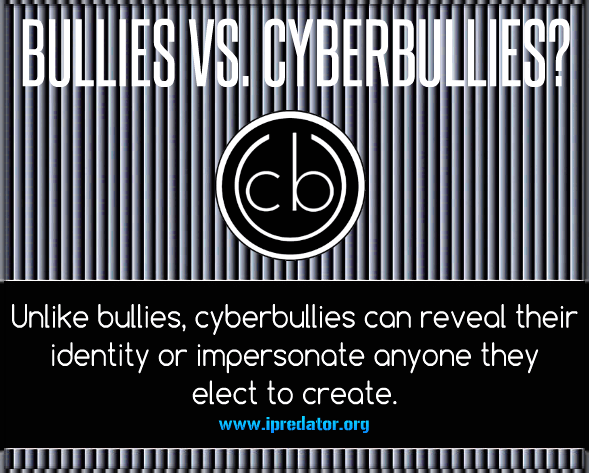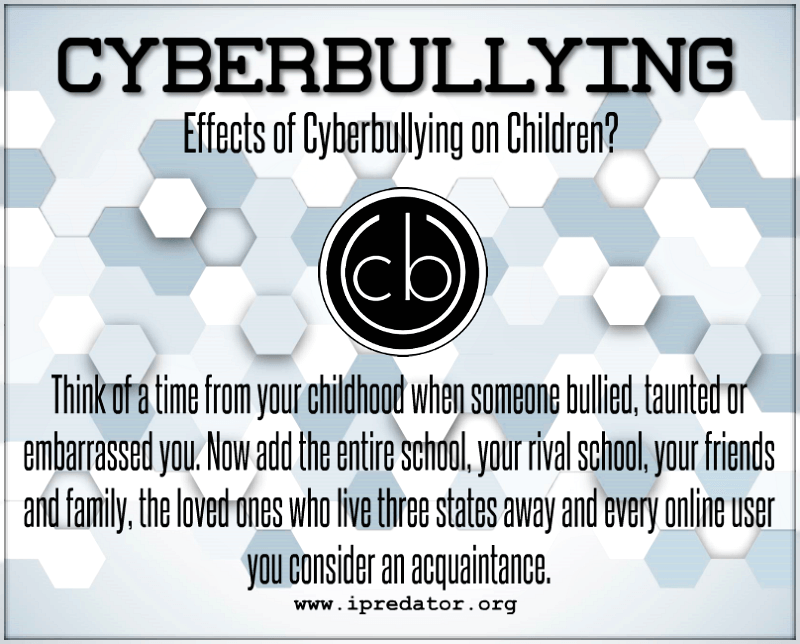The Cyberbully Mind and a brief introduction to the Psychodynamics of Cyberbullying are presented. Cyberbullying is defined as the use of Information and Communication Technology (ICT), by a minor, to verbally and/or physically attack another minor, who is unable or unwilling to deescalate the engagement. Given that the vast majority of this abuse occurs in cyberspace, the factors, drives and motivations for cyberbullying are explored.
Bullying, or classic bullying, is a term used to define recurrent and sustained verbal and/or physical attacks by one or more child(s) towards another child who is unable or unwilling to deescalate the engagement. It may involve verbal harassment, physical assault, coercion, intimidation, humiliation and taunting. Bullying is comprised of a combination of five types of pediatric abuse: social, sexual, emotional, verbal and physical.
Bullying requires both the assailant and target to be minors. Adult forms of bullying are termed Harassment, Stalking & Slander. Despite variants in definition, bullying involves abuse between two or more minors. Classic bullying requires face- to-face interactions within the repertoire of aggressive behaviors.
Cyberbullying and the cyberbully are terms used to define recurrent and sustained verbal and/or physical attacks, by one or more children towards another child, who is unable or unwilling to deescalate the engagement using Information and Communication Technology (ICT). Like classic bullying, the cyberbully engages in harmful, repeated and hostile behavior intended to deprecate a targeted child. Cyberbullying describes threatening or disparaging communications delivered through ICT. Whereas classic bullying involves face-to-face interactions and non-digital forms of communication, cyberbullying consists of information exchanged via ICT and may never involve face- to-face encounters.
Classic & cyberbullying occurs among young people. When an adult is involved as the aggressor, it meets criteria for cyber harassment or cyberstalking, which in many states is a criminal act. Although the terms bullying and cyberbullying includes adult intimidation behavior in contemporary culture, these describe pediatric behaviors and will not include adult applications in this manuscript.

Cyberbully Minds, Bullying
and
Cyberbullying Psychodynamics
Children of the 21st century are targeted via classic bullying, the cyberbully or a combination of the two. Given the evolution of digital technology, growth of the internet and its relevance to the human experience, cyberbullying has reached epidemic proportions among the pediatric segments of society and becoming a permanent weapon in the toolbox of pediatric aggressors. At the core of all bullying, cyber and classic, are victimization, disparagement and abuse of a targeted child. Child abuse, whether perpetrated by a child or adult, is detrimental to all aspects of their psychological and developmental maturation following them into adulthood and throughout their lifespan.
Children traumatized by abuse and victimization have higher rates of all negative psychological and sociological aspects of the human condition ranging from alcohol & drug abuse, criminal involvement, domestic abuse and psychiatric illnesses. With the advent of ICT, children are by far more susceptible to the nefarious, criminal and deviant aspects ICT offers humanity. Although ICT offers incredible benefits to society, children are the demographic segment that is most impacted by the Dark Side of Cyberspace.
“Being the richest man in the cemetery doesn’t matter to me. Going to bed at night saying we’ve done something wonderful, that’s what matters.“ Steve Jobs (1955-2011)
In the United States, October has been marked every year as National Crime Prevention Month, National Bullying Prevention Month & National Cyber Security Month. America must recognize the adverse societal outcomes if cyberbullying is not addressed immediately. Given the complexity of cyberbullying, religious organizations, educational systems and communities must work together to initiate and sustain a concerted effort.
A Canadian educator, Bill Belsey, in 2008 coined the term, cyberbullying, defining it as, “involving the use of information and communication technologies such as e-mail, cell phone and pager text messages, instant messaging, defamatory personal websites, and defamatory online personal polling websites, to support deliberate, repeated, and hostile behavior by an individual or group, that is intended to harm others.“
iPredator is a new construct developed by this writer to describe those, children and adults, who use ICT to assault, victimize and steal from others. Based on this writer’s hypothesis, 80-85% of cyberbullies meet the requirements of iPredator and defined below:
In relationship to cyberbullying, this writer along with developmental experts and philosophers, views bullying as driven by a need for control and domination, perceived by a child, that his/her actions will lead to greater peer acceptance and recognition. Alfred Adler (1870-1937), postulated that all people, feeling encouraged, concurrently feel proficient, appreciated and will behave in a connected and cooperative way. When discouraged, humans act in unhealthy ways by competing, withdrawing or giving up. It is in finding ways of expressing and accepting encouragement, gaining respect, and practicing Social Interest that help people to feel fulfilled and optimistic.
Adlerian theory and practice have proven especially relevant applied to the growth and development of children. A disciple of Alfred Adler, Rudolf Dreikurs [1897-1972], stated “a misbehaving child is a discouraged child“ and that helping children to feel valued, significant and competent is often the most effective strategy in coping with difficult child behaviors. As this writer strongly supports many of his tenets, Adler’s theory would define a bully or cyberbully as compensating for deep feelings of inferiority. Inferiority is universal in all children and is the proclivity to feel smaller, weaker and less socially & intellectually competent than the adults around them.
Adler suggested if one observes children’s games, toys and fantasies, they tend to have one thing in common: the desire to grow up, to be big and to be an adult. This kind of compensation is identical with striving for perfection. Many children, however, are left with the feeling that others will always be better than they are. These psychic experiences of feeling less than, compounded by striving to feel superior and accepted by others, are the elements that lead a child to harass and taunt other children. From Adler’s theoretical tenets, it becomes plausible to see why children engage in abusive actions towards other children knowing their actions are causing the target child distress.
Although highly detrimental to the targeted victim, Dark Psychology assumes the aggressor child’s purpose for their behavior, using Adlerian theory regarding “need for acceptance”, as a primary motivating force for their behavior, is a viable explanation. When the aggressor child’s internal experiences and perceptions moves into the area of feeling gratification, power, dominance and control, without care or thought of the target child’s well-being, Dark Psychology defines this psychological state as deviant, narcissistic, anti-social and psychopathological. These behaviors may blossom into serious aggressive and/or criminal behavior in adulthood if not squelched or addressed.
Regarding this writer’s construct of iPredator, cyberbullying falls within the iPredator definition when the aggressor(s) is fully aware of his/her intent but continues in his/her abusive pattern despite being fully aware that he/she are causing the target child significant distress. In order to classify a child as an iPredator, they must know their behaviors are causing anguish in a target child.
The actual percentage of cyberbullying that occurs without the aggressor’s knowledge of causing a target child anguish would be exceedingly difficult to compile with high certainty. Many children do inadvertently insult and deprecate other children online without knowing they are doing so thinking they are being humorous and clever. All present estimates on a child’s modus operandi for bullying another child has been derived through interviews and self-report with no accurate way of confirming their honesty. Of those children who are not aware of their abusive actions, they are not included as iPredators or defined using Dark Psychology tenets.
Included in this writer’s two concepts of Dark Psychology and iPredator are those children that are fully aware of their abusive behaviors but continue to target the victim. There are two sub-groups of children, that iPredator and Dark Psychology addresses as they meet each concept’s criteria. As part of this writer’s pediatric cyberbullying construct, Cyberbully Triad, these two groups are called Righteous Cyberbully & Narcissistic Cyberbully.
The first group of cyberbullies, Righteous Cyberbully, are aware of their actions, understands they are causing the target child distress, understand their actions are wrong, but continues to do so because they believe the target child deserves their assaults. The Righteous Cyberbully feels warranted in his/her actions for reasons including:
- I. The target child offended or abused the aggressor in the past from bullying or an isolated aggressive event.
- II. The target child offended or abused a peer or loved one close to the aggressor in the past from bullying or an isolated aggressive event.
- III. The target child offended the aggressor’s belief system due to their race, religious affiliation, physical presentation, socio economic status, sexuality and any other aspects the aggressor deems offensive, immoral or unjust.
Of all types of cyberbullies, the most concerning and potentially dangerous segment are those children engaged in cyberbullying with full knowledge of their actions, understand the distress they are causing the target child and continue their assaults motivated by sheer malevolent intent. This segment in the Cyberbully Triad is called the Narcissistic Cyberbully. Unlike the group just described motivations for this group, by blaming the target child or feeling justified based on the target child’s genetic and cultural make up, are not experienced.
These children may verbalize to their peers they are inflicting their wrath upon the victim for reasons described above, but they are not motivated by these reasons, but by sheer enjoyment of inflicting abuse upon others. Of the total population of cyberbullies, this segment of children is the smallest, but most dangerous to society. Children within this group are the future sociopaths, criminals and psychopaths, which victimize and inflict pain on others as adults, devoid of remorse.
Society will never mandate all children to be evaluated for antisocial and narcissistic personality disorder tendencies, nor is this writer encouraging mandatory assessments for all children. What this writer is pointing out is that cyberbullying is an immoral and destructive behavior that causes the target child serious distress and psychological wounds that can last the rest of their lives. Whether the aggressor is ignorant to their cyberbullying, feels justified by their distorted belief systems, or at the beginning stages of being a future narcissist or sociopath, society must treat all children as having the same potential both as aggressor and as victim.
It is for this reason of never knowing the impact cyberbullying will have upon the aggressor, victim and the community, that consistent and regular education cannot be encouraged enough. Most children who are cyberbullying and being cyberbullied rarely disclose this information to parents or teachers. As this writer, along with all citizens of the world thrive at the beginning of the Information Age, answers to the questions of the societal impact of cyberbullying will be addressed by future generations.
“What will become of today’s cyberbully tomorrow? They have grown into adults and spent their entire lives learning and carrying out how to best devastate other using Information and Communications Technology.“ Michael Nuccitelli, Psy.D. (2011)
Examples of Cyberbullying Images

Free Educational Cyberbullying Assessments
- Cyberbully Abuser Checklist (CBAC)
- Cyberbullying Target Checklist (CBTC)
- Cyberbullied Probability Inventory (IPI-CB)
- Cyberbully Probability Inventory (IPI-CBA)
Michael Nuccitelli, Psy.D.
Michael Nuccitelli, Psy.D. is a NYS licensed psychologist, cyberpsychology researcher and online safety educator. In 2009, Dr. Nuccitelli finalized his dark side of cyberspace concept called iPredator. Since 2010, he has advised those seeking information about cyberbullying, cyberstalking, cybercriminal minds, internet addiction and his Dark Psychology concept. By day Dr. Nuccitelli is a practicing psychologist, clinical supervisor and owner of MN Psychological Services, PLLC. After work and on the weekends, he volunteers helping online users who have been cyber-attacked. Dr. Nuccitelli’s is always available to interested parties and the media at no cost. This website and everything created by Dr. Nuccitelli is educational, free and public domain.

